What’s Happening Here?
I’m generally a fan of things with spots. I mean what’s not to like about a good polka-dot pattern? Dalmatians and ladybugs to name a few. Admittedly, my admiration of spots goes away when they appear unexpectedly on perennials. Let me show you an example of unexpected and undesirable spots that appeared on penstemon:
As you can see, unless you’re a pathologist, these spots are not exciting and greatly reduces the aesthetic appearance of the penstemon. If you haven’t figured it out already, this is a diagnostic challenge. Sure, I hinted that a pathologist could get excited by these spots, but do you know what’s causing them?
It's now time for me to ask, “What’s happening here?” Take your time contemplating the possibilities as you enjoy the newsletter. I’ll reveal the answer in just a few minutes.
It’s Time for Some Garden Candy
This isn’t your normal type of candy. I wanted to share Plant Nouveau’s new Garden Candy intersectional peony cultivars. Here’s just a sampling of the wonderful treats available in the series:
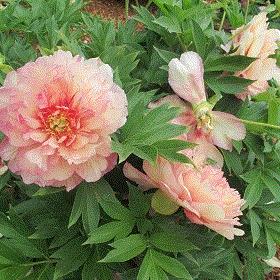
Truly Scrumptious - Peachy orange to creamy white flowers fade to pink toward the edges
|
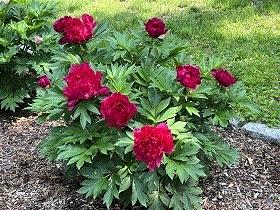
Candy Apple - Large, red double flowers
|
|
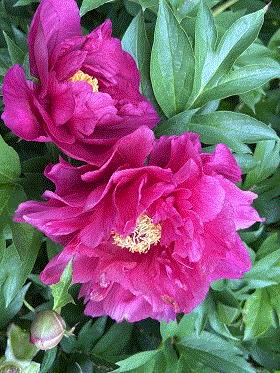
Noa Jolie - 6- to 8-in. flowers with baby pink petals and raspberry red edges
|
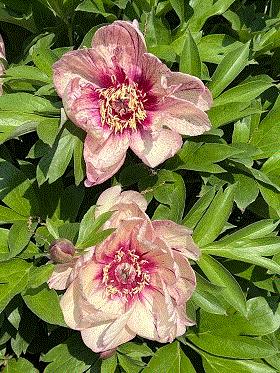
All That Jazz Cream - Double flowers with maroon to eggplant-purple stripes
|
These delectable Garden Candy ITOH peonies are definitely sweet eye candy and would make great additions to premium perennial programs. Each of these cultivars bloom in the early summer, grows 3-ft. tall by 3-ft. across and are cold hardy all the way to Zone 3.
Ellen’s Assignment
The new school year is in full swing. While taking in all the great content in buZZ! (a weekly newsletter covering retail news from the green industry) by Ellen Wells, I thought her article on internships was worth sharing with you. Rather than paraphrasing her article, here it is in its entirety:
Hort Students, Your First Assignment
Which is right for you? Well, I’ll explain the differences and you pick which is up your alley.
The Vic & Margaret Ball Intern Scholarship Program will give you experience in a commercial production greenhouse or nursery. And you’ll get paid for it, too. The program offers internships in three-, four- or six-month lengths and provides scholarships of up to $6,000. And your faculty advisor can be reimbursed up to $1,000 in traveling expenses to visit you at your internship location. Sweet!
The Mosmiller Intern Scholarship Program is for students pursuing a career in retail or wholesale operations. Another paid internship, the Mosmiller program offers 10- to 16 week internships and provides scholarships of $2,000.
Trust us, students—internships are the best way for you to gain real, hands-on experience that’ll help you practice and expand your knowledge. Applications for both intern opportunities are due October 1. Apply
HERE.
Thank you, Ellen, for this article and all the great content you pack each week into the buZZ!
newsletter. If you’re not already familiar with buZZ!
, I invite you to read Ellen’s latest edition. 
It’s Here: The 2025 IMF Guide
The 2025 version of GrowerTalks' supplemental Insect, Miticide & Fungicide Guide is now available. If you’re looking for a treasure trove of pest management content, look no further. I invite you to download your very own FREE copy of the 2025 Insecticide, Miticide & Fungicide Guide.
The newest edition contains tons of content, including chemical class charts, an extensive insecticide/miticide table and numerous articles from several of the industry’s top experts. Curious, but not quite ready to hit the download link above? How about I give you a glimpse of what’s inside the guide?
Designing Programs
-
Building Better Fungicide Programs: Balanced Plant Protection Solutions
-
Building Better Insecticide Programs: Basic Rotations + Functional Glow Up
Informative Charts and Tables
-
Chemical Class Chart for Greenhouse Nursery Fungicides
-
2025 Insecticides and Miticides for Managing Insect and Mite Pests of Greenhouse Grown Horticultural Crops—Raymond A. Cloyd Department of Entomology Kansas State University
Excellent Articles from Industry Experts
-
Downy Mil-dos & Don’ts—Francesca Peduto Hand, Ph.D., Department of Plant Pathology, The Ohio State University
-
Getting the Jump on Foliar Disease Problems—Tom Creswell, Ph.D. & John Bonkowski, D.P.M., Plant and Pest Diagnostic Laboratory, Purdue University
-
Apply Preemergence Herbicides Accurately & Uniformly (Easier Said Than Done!)—Joseph C. Neal, Ph.D., Professor of Weed Science, Department of Horticultural Science, North Carolina State University (Weeds are pests too!)
Besides these great features, there’s even more great content in the guide. I’d like to give a great big THANK YOU to BASF for sponsoring and making the 2025 IMF Guide possible. Muchas gracias!
That reminds me—the guide is also available in Spanish.

The Answer is ...
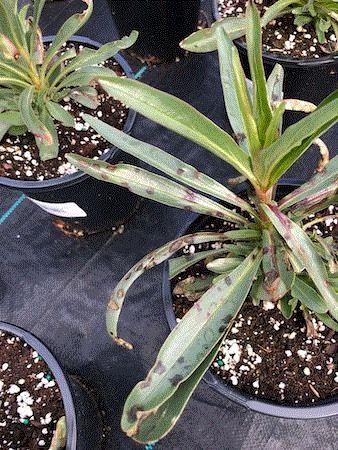
I shared this image of leaf spots on penstemon at the top of the newsletter and asked if you could identify what's causing them. I gave a subtle hint that a pathologist would get excited by them indicating that this is some type of disease. This rules out a few of the possibilities. Before the big reveal, let’s take a closer look:
I think many subscribers just locked into their answer. If you’re one of them and answered the spots are bacterial leaf spots, congratulate yourself, give yourself a pat on the back, reward yourself with ice cream or whatever you see fit.
I didn’t have this bacterial leaf spot diagnosed, but I typically find Pseudomonas spp. is responsible for bacterial leaf spots on penstemon.
Managing This Week's Challenge
Regardless of the bacterial organism causing the leaf spot, I generally manage them similarly.
First and foremost, take steps to manage the environmental conditions when possible. Avoid long durations of leaf wetness, avoid splashing water from plant to plant and water when the foliage can dry quickly.
Bacterial leaf spots can be tough to control once they set in. Therefore, bactericides are best applied preventatively, but they can definitely slow down the spread and severity of infections that have already started. Many growers use KleenGrow, copper-based fungicides (
Phyton 27,
Camelot O,
Grotto) and products containing
Bacillus amyloliquefaciens (
Triathlon BA,
Bacilirid) to manage bacterial leaf spots. I prefer to rotate between each type of these products when managing bacterial diseases.
Make preventive applications at seven- to 14-day intervals. Use the shortest interval (seven days) when disease pressure is present or the envrionmental conditons are favorable for disease development.




Thanks for reading this edition of Perennial Pulse. My email is paul@opelgrowers.com if you have any comments, article suggestions or if you'd just like to say hello.
Best regards,

Paul Pilon
Editor-at-Large—Perennial Pulse
Director of Growing—Opel Growers
This email was received by you and 34,462 other fine subscribers!
If you're interested in advertising in Perennial Pulse, contact Kim Brown ASAP and she'll hook you up.